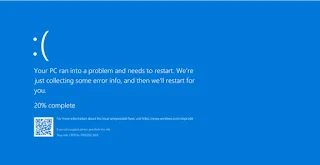History Time Line Fun Facts of The Blue Screen of Death
History Time Line Fun Facts of The Blue Screen of Death
The Blue Screen of Death (BSOD), officially known as a "stop error,"
The Blue Screen of Death (BSOD) is a fatal system error screen that appears when Microsoft Windows encounters a critical issue that it cannot recover from.
It has evolved over time, reflecting changes in Windows and computing technology. Here’s a brief history of the BSOD:
Early Days (Windows 1.0 - Windows 3.x, Late 1980s - Early 1990s)
The earliest versions of Windows didn't have a BSOD in the modern sense.
When Windows 3.1 encountered a system crash, it would show a white text-on-blue error screen, similar to DOS error messages.
These errors were mainly caused by hardware failures, memory issues, or conflicts with device drivers.
Windows 95 - Windows ME (1995-2000): The Classic BSOD
Windows 95 introduced a more recognizable BSOD format with white text on a blue screen.
It displayed error codes and troubleshooting hints, typically caused by memory issues, hardware driver failures, or corrupt system files.
The infamous "Press any key to continue" prompt became a meme.
Windows ME, known for instability, had frequent BSOD occurrences.
Windows XP (2001-2008): More Details, Still Common
XP's BSOD was more detailed, showing hexadecimal error codes and driver names.
It became one of the most widely seen BSODs due to XP’s popularity.
Many crashes were due to driver conflicts or RAM/hard drive failures.
"Bad Pool Header" and "IRQ Not Less or Equal" became well-known error messages.
Windows Vista & Windows 7 (2007-2015): Less Frequent, More Logging
Vista improved system stability, reducing BSODs.
Windows 7 introduced better automatic recovery, meaning BSODs were less frequent.
System Restore and improved diagnostics helped users troubleshoot crashes.
Windows 8 & Windows 10 (2012-2021): The Sad Face Era
Windows 8 revamped the BSOD with a simplified error message and a frowning emoticon (😟), along with a QR code linking to troubleshooting tips.
Windows 10 continued this trend, making the BSOD less intimidating.
The Blue Screen of Death (BSOD) in Windows 11 continues its legacy as the operating system’s way of signaling a critical failure,
Windows 11 (2021-Present): Black & Blue Screens
Windows 11 initially changed the BSOD to a black screen, but later reverted to blue due to user feedback.
It includes more automatic recovery features, reducing the need for manual troubleshooting.
Famous BSOD Incidents
1998 COMDEX Presentation: Bill Gates was demonstrating Windows 98 when it crashed with a BSOD, causing laughter from the audience.
Windows 10 Updates: Some updates caused BSODs, leading to mass complaints.
Legacy & Cultural Impact
The BSOD has been referenced in pop culture, memes, and even t-shirts.
Photo - BSOD image

1 comments:
yes its last stage